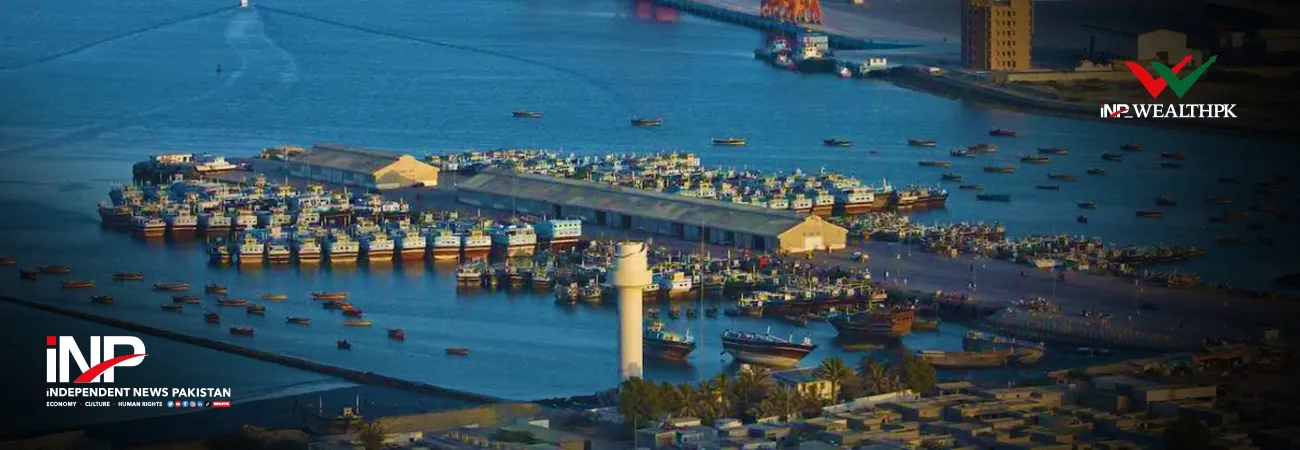INP-WealthPk
Ayesha Saba
Embracing a vision to transform the world into a global village with abundant opportunities of socio-economic prosperity equally available to all brackets of society, the China-Pakistan Economic Corridor (CPEC) project set its foot in Pakistan in 2013.
With 2023 marking its 10th anniversary, this multibillion-dollar initiative – a flagship project of the Belt and Road initiative – has contributed immensely towards Pakistan’s efforts for economic uplift, sufficiency in energy, and fight against poverty by opening doors to foreign and local investment in a myriad of projects.
This article gives a broad outline of this ambitious project that ties Pakistan and China in a symbiotic relationship equally beneficial to both.
1. Introduction
The plans for an economic corridor between Pakistan and China preceded the Belt and Road Initiative (BRI). The project was first announced in the summer of 2013 when the then prime minister of Pakistan met then Chinese primer in Beijing.
The focus was on connecting China with Gwadar through highway, rail, and pipeline infrastructure. The project plans had a five-year horizon for implementation, and the sums involved – ranging between USD 10 and 20 billion – were moderate compared to China’s current ambitions in Pakistan.
The agreements and MoUs initially signed under the project totalled around $46 billion with investments in energy (power) and infrastructure. The project virtually connects Kashgar city with the Gwadar Port in Balochistan province.
CPEC is a journey towards economic regionalization in the globalized world. It founded peace, development, and a win-win model for all. The project promises a better future region with peace, development and economic growth.
2. Major components
The three major components of the project include investments in
- Infrastructure development (road, optical fibre cable and railway networks)
- Energy (power) sector and
- Special economic zones
- International cooperation, agriculture, science & technology, and information technology are newly added, and currently at the planning stage for third-party participation.
3. CPEC at a glance (90 projects, ~54 billion USD)
- 27 projects completed with an investment of USD19 billion.
- 27 projects are under implementation with an investment of USD7.7 billion and will be completed by 2025.
- 36 projects are in the pipeline with approximate investment of USD27.5 billion and will be completed by 2030.
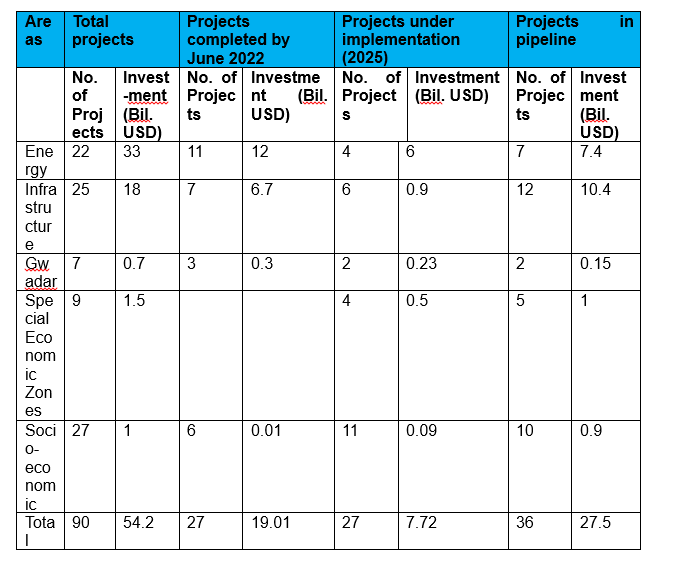
Four out of the nine identified Special Economic Zones (SEZs) would be completed by 2025 against an investment of $500 million, while the remaining five SEZs would be completed by 2030 with investment of $1 billion, the CSAIL report reveals.
In addition, six socio-economic projects have been completed so far with an investment of $10 million. Eleven projects worth $90 million will be completed by 2025, while 10 projects worth $900 million will be ready by 2030.
4. Stages in development of projects
The stages in the development of CPEC projects are as follows:
- Early Harvest 2015-2018: A majority of projects related to the energy sector are ready for completion or are in the process of completion, thus greatly alleviating energy shortages and load shedding issues that had crippled exports and industry.
- Short-term projects up to 2020: Mainly roads, Gwadar development, optic fibre network and hydel, coal mining and power projects.
- Medium projects up to 2025: Hydel power plants, railways, and industrial zones.
- Long-term projects up to 2030: Completion of industrial zones, agriculture, tourism, science & information technology, etc.
5. Infrastructure development projects under CPEC
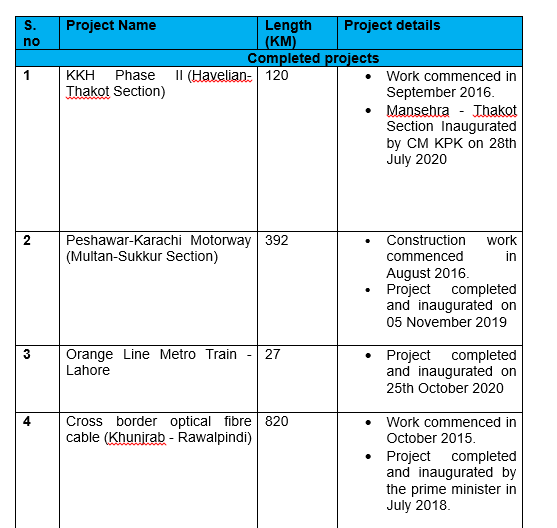
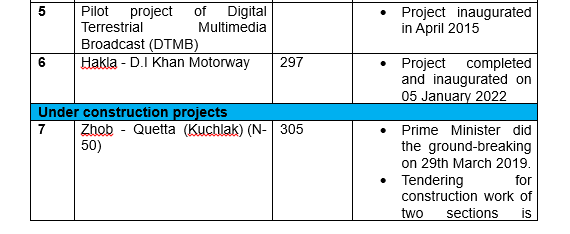

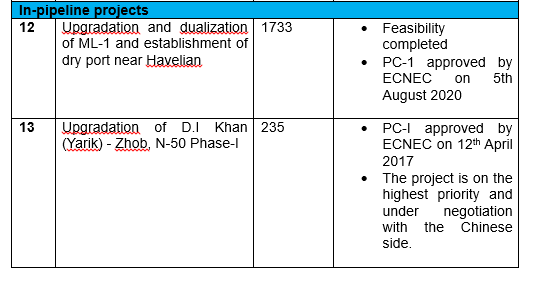
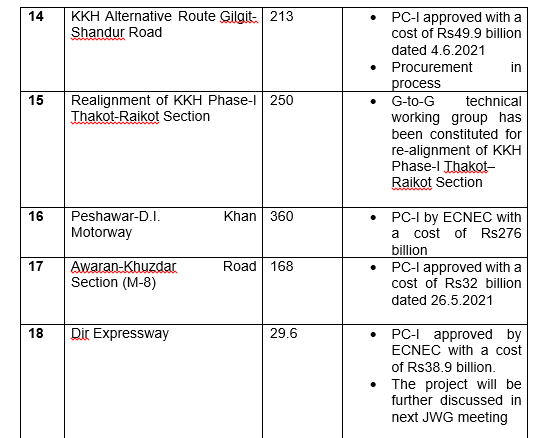

The China-Pakistan cross-border economic belt, linked by the Karakoram Highway, has taken shape. Through international logistics nodes such as Gwadar Port, Karachi and Peshawar, Pakistan serves to transport products from western China to countries in the Middle East and the Indian Ocean via transit transport. Therefore, infrastructure connectivity is also one of the important areas in the early harvest projects of the CPEC.
The project will ensure efficiency in terms of development in trade and transport, thus improving the economy.
The increase in economic activity under CPEC will have a positive impact on trade and commerce. The development of transport infrastructure will reduce the current infrastructure deficit, facilitate the connection of the production base with domestic and foreign markets, promote market competitiveness and production of high-quality products through internal connectivity by decreasing transportation costs and post-production losses, rectify Pakistan's regional integration and strengthen economic integration with easy market access to China and other regional trading partners.
Talking to WealthPK, Prof Dr. Fakhr-ul-Islam, Director of Pakistan Study Centre, University of Peshawar, said, “Our economy is changing apace because of rapid globalization. The development of road network and its expansion have boosted domestic economic expansion.”
“CPEC’s vision and mission to enhance geographical linkages and economic development through trade linkages can be attained by improving the transportation infrastructure,’’ he said.
“Pakistan will be able to accrue the full benefit of this gigantic project through an upgraded and expanded road network in order to meet the future potential increases in traffic and product movement. While expanding the road networks, innovative financing techniques, private sector participation, and environmental concerns must all be taken care of,’’ he added.
6. Improving macroeconomic conditions in Pakistan
The CPEC projects have been a catalyst for driving development in Pakistan in recent years. The projects have solved the problem of limited investment capacity caused by insufficient savings and shortage of foreign exchange and foreign direct investment (FDI) and provided a high-quality source of impetus for economic development.
As of June 2022, 27 projects with an investment of around $19 billion have been completed, while 27 projects with an investment of around $7.7 billion are in the construction stage. It drove Pakistan's economic growth by one to two percentage points every year and created 46,500 job opportunities. As a result of these projects, Pakistan's macroeconomic conditions have started improving and the economy is maintaining a momentum of rapid growth.
7. Poverty alleviation
The project is aimed at uplifting the socio-economic development of Pakistan and in doing so facilitating poverty alleviation by expanding employment opportunities. Poverty alleviation is a long-term spill-over effect of this multimillion-dollar project. The construction of regional infrastructure has helped increase the standard of living and poverty reduction by connecting isolated places and people with major economic centres and markets, narrowing the development gap among a region.
Against this backdrop, CPEC is increasing geographical connectivity and creating direct employment opportunities for individuals in the proximate areas where these projects are being implemented, leading to increased household income.
CONCLUSION
China is eagerly working on regional integration and has invested a huge amount in infrastructure development, especially in South Asia. All these developments indicate that there would be economic integration in the region.
According to Vision 2025 of the Ministry of Planning and Development of Pakistan, there should be an efficient and integrated transportation and logistics system that will facilitate the development of a competitive economy. It sees the establishment of industrial parks and development of Special Economic Zones as an important part of strengthening the transportation network and logistics infrastructure along CPEC.
The Corridor is the most significant consensus by the leaders of China and Pakistan. It will optimize bilateral trade and energy cooperation and benefit over three billion people in China, South Asia and the Middle East.
The project realizes the new realities of global and regional politics by cultivating a more systematic, upgraded and need-based interaction for socio-economic, industrial, energy, and trade development. It will transform Pakistan’s geographical location into an asset. The business community and private sector need to come forward and play their role in making CPEC a success.
Credit: INP-WealthPk



